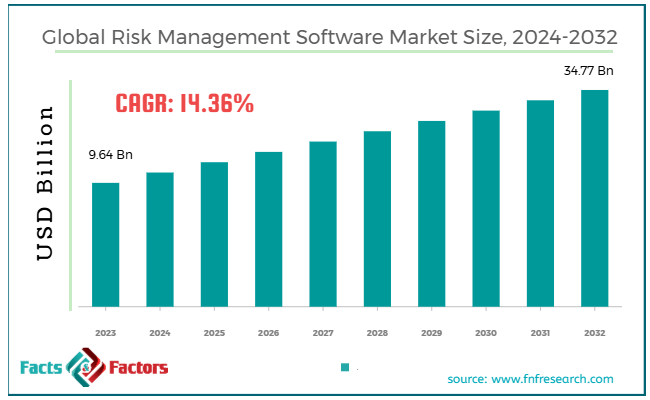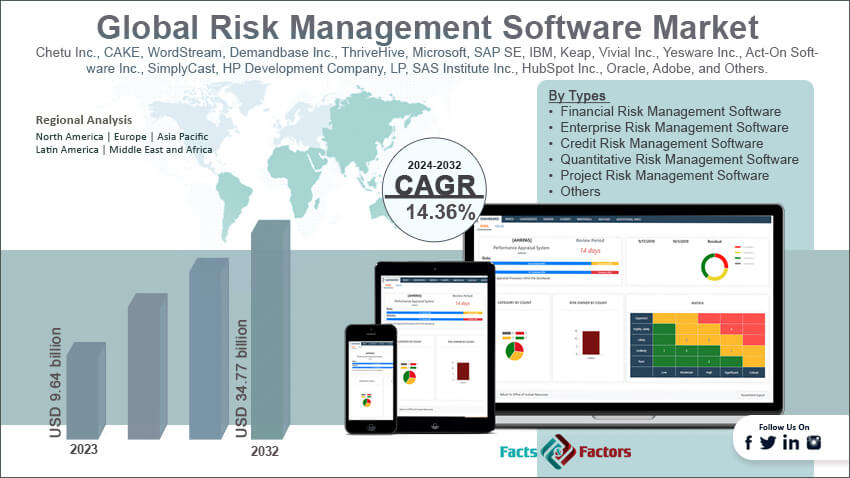 en
en  en
en  en
en  en
en 
[214+ Pages Report] According to Facts & Factors, the global risk management software market size was valued at USD 9.64 billion in 2023 and is predicted to surpass USD 34.77 billion by the end of 2032. The risk management software industry is expected to grow by a CAGR of 14.36% between 2024 and 2032.

 Market Overview
Market OverviewRisk management software refers to the digital tools that help mitigate risks that can affect the company's reputation and finances. These risks include cyber security threats, financial losses, operation disruptions, regulatory issues, and many others. This software helps businesses with efficient approaches to manage risks and ensure business continuity.
These software are more cost-effective in nature. These work by monitoring the potential bottlenecks in businesses and implementing mitigation strategies to avoid any losses or disruptions.
 Key Insights
Key Insights
 Growth Drivers
Growth DriversOrganizations globally are witnessing the changing regulatory landscape, which is a major factor in the high growth rate of the global risk management software market. Governments around the world have come up with different regulatory acts like the Health Insurance Portability And Accountability Act (HIPAA), General Data Protection Regulation (GDPR), and Sarbanes-Oxley Act (SOX) to protect the data and identity of individuals.
However, businesses are adopting risk management software to track and manage audits in order to avoid penalties. Also, there are many sector-specific regulations, particularly with BFSI, healthcare, and energy sectors, which are further expected to support the growth of the industry.
Additionally, the growing cyber security threats are encouraging businesses to adopt cyber security risk management software to ensure data protection and mitigate cybersecurity risk. For instance, Riskonnect successfully acquired Castellan in 2022 to expand the company's offering in order to address the rising concerns of risk management.
 Restraints
RestraintsThe high upfront cost of implementing risk management software is expected to hinder the growth of the risk management software industry. This cost factor is a barrier for enterprises with limited budgets. Moreover, organizations nowadays require more customized solutions that can align with their goals and needs, further adding up to the overall cost.
 Opportunities
OpportunitiesCloud-based risk management software is gaining immense traction among end-users because of its high scalability, flexibility, and cost-effectiveness. It is ideal for businesses of all sizes without posing any requirement of heavy upfront investment in infrastructure. Cloud-based solutions help business teams access the data and collaborate with the mitigation strategies remotely, thereby making it convenient for organizations to work in a decentralized environment.
Also, companies are inclining more towards integrated risk management solutions to offer unified solutions to avoid a wide range of risks like security, financial, operational, and compliance on one platform, which is another major factor likely to positively impact the growth of the global risk management software market.
For instance, SAS successfully took over Kamakura Corporation in 2022 to improve risk technology innovation and offer advanced analytics solutions.
 Challenges
ChallengesDeploying risk management software into the existing system is complex, resource-intensive, and time-consuming. Sometimes, organizations are required to hire professional help or consultants to manage the installations. Therefore, such a landscape is a big challenge in the risk management software industry.
 Segmentation Analysis
Segmentation AnalysisThe global risk management software market can be segmented into types, deployment models, industry verticals, components, and regions.
On the basis of types, the market can be segmented into financial risk management software, enterprise risk management software, credit risk management software, quantitative risk management software, project risk management software, and others.
Credit risk management software segment accounts for the largest share of the risk management software industry. There is a high demand for credit risk management software in financial institutions as this sector works on the creditworthiness of the borrowers.
Also, the sector witnesses many loan defaults, and there is constant pressure on them to come up with profitable businesses, which is another major factor fueling the growth of the segment. This software helps eliminate bad debts and loan defaults by accessing customer profiles and avoiding risky loans. This software also facilitates real-time monitoring of credit scores, thereby offering end-users proactive measures to prevent their losses.
On the basis of deployment models, the market can be segmented into on-premise and cloud. The cloud model is the fastest-growing segment in the global risk management software market. Cloud-based solutions are cost-efficient as they do not require a high upfront investment. Organizations prefer a subscription-based model, which eliminates the requirement for any heavy investment in IT infrastructure.
Cloud solutions are more scalable in nature and help businesses to fluctuate their management capabilities on the basis of the requirement. Also, cloud-based models facilitate faster installations and updates by eliminating any possible downtime.
Additionally, end-users are well-equipped with the latest features and security improvements without any need for professional help. Cloud solutions offer remote accessibility, thereby facilitating greater operational flexibility to end-users. Cloud-based risk management software offers unique features like continuous monitoring, multi-factor authentication, and better encryption that assure proper data protection and risk management practices.
On the basis of industrial verticals, the market can be segmented into food & beverage, manufacturing, retail, healthcare, transport & logistics, consumer goods, and others. The transport and logistics segment is likely to dominate the global market during the forecast period. The complex nature of the supply chain poses risks like customer issues, shipping delays, geopolitical instability, and many other disruptions, which increase the demand for risk management software in the market.
Also, the growing globalization of trade, along with the emergence of just-in-time delivery models further fuel the requirement for advanced solutions to eliminate potential risks. Also, the effective management of fleets, including vehicle breakdown, logistic failures, or accidents, further poses huge requirements for solutions that can help the company track real-time data on driver behavior, routes, and vehicle performance and facilitate smooth operations.
On the basis of components, the market can be segmented into software and services. The software segment is anticipated to witness significant developments in the global risk management software market in the coming years. The growth of the segment is highly characterized by the rising risk in businesses caused by expansion and advancements in the processes.
However, the inclusion of machine learning and artificial technology into the risk management software is one of the major factors fueling the growth of the segment. These technologies help organizations take proactive measures to eliminate potential bottlenecks with accurate predictive analytics.
Also, the rising cyber threats, particularly in the fields of healthcare, finance, and e-commerce, are further posing huge requirements for cyber risk management software. The emergence of big data helps businesses offer actionable insights in real time to help companies make more data-driven and informed decisions.
 Report Scope
Report ScopeReport Attribute |
Details |
Market Size in 2023 |
USD 9.64 Billion |
Projected Market Size in 2032 |
USD 34.77 Billion |
CAGR Growth Rate |
14.36% CAGR |
Base Year |
2023 |
Forecast Years |
2024-2032 |
Key Market Players |
Chetu Inc., CAKE, WordStream, Demandbase Inc., ThriveHive, Microsoft, SAP SE, IBM, Keap, Vivial Inc., Yesware Inc., Act-On Software Inc., SimplyCast, HP Development Company, LP, SAS Institute Inc., HubSpot Inc., Oracle, Adobe, and Others. |
Key Segment |
By Types, By Deployment Models, By Industry Verticals, By Components, and By Region |
Major Regions Covered |
North America, Europe, Asia Pacific, Latin America, and the Middle East &, Africa |
Purchase Options |
Request customized purchase options to meet your research needs. Explore purchase options |
 Regional Analysis
Regional AnalysisNorth America will account for the largest share of the global risk management software market during the forecast period. The region is the major target for data breaches and cyber-attacks, which is a major factor encouraging organizations to invest in efficient risk management software. Also, there is growing interest in cloud-based models to eliminate infrastructure costs and improve efficiency & flexibility.
Moreover, these are scalable solutions that help businesses in the region utilize their resources according to their requirements. The regulatory environment in the US is quite complex, which is another crucial factor for the high growth rate of the regional market. Organizations in the region need to comply with regulatory frameworks like GDPR, HIPAA, SOX, and many others, and therefore, they need risk management software to ensure ongoing regulatory adherence.
Asia Pacific is another major region in the risk management software industry that is expected to witness significant developments in the coming years. The ongoing digital transformation initiatives in APAC are causing complexity in risk management. Therefore, companies that are evolving on a large scale need to invest in efficient risk management solutions to manage operational risks.
Also, the shifting attention of the government in the region on ESG risk is further expected to strengthen the demand for risk management solutions in the region. Businesses are also integrating ESG assessments into their operational strategies to ensure their compliance with environmental laws. China is the leading market in the region because of the strong emphasis of government and organizations on cybersecurity solutions.
Moreover, the fast-growing BFSI sector in India is further posing a huge requirement for data protection and compliance solutions, which in turn is also expected to support the growth of the regional market. Countries like Japan, Australia, South Korea, and other Southeast Asian nations are driving demand for risk management software, which is expected to positively impact the growth trajectory of the regional market.
 Competitive Analysis
Competitive AnalysisThe key players in the global risk management software market include:
 By Types Segment Analysis
By Types Segment Analysis By Deployment Models Segment Analysis
By Deployment Models Segment Analysis By Industry Verticals Segment Analysis
By Industry Verticals Segment Analysis By Components Segment Analysis
By Components Segment Analysis By Regional Segment Analysis
By Regional Segment Analysis

Copyright © 2024 - 2025, All Rights Reserved, Facts and Factors
 en
en  en
en